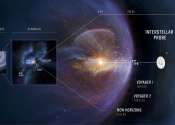Voyager seeks the answer blowin' in the wind
(PhysOrg.com) -- In which direction is the sun's stream of charged particles banking when it nears the edge of the solar system? The answer, scientists know, is blowing in the wind. It's just a matter of getting NASA's Voyager ...









